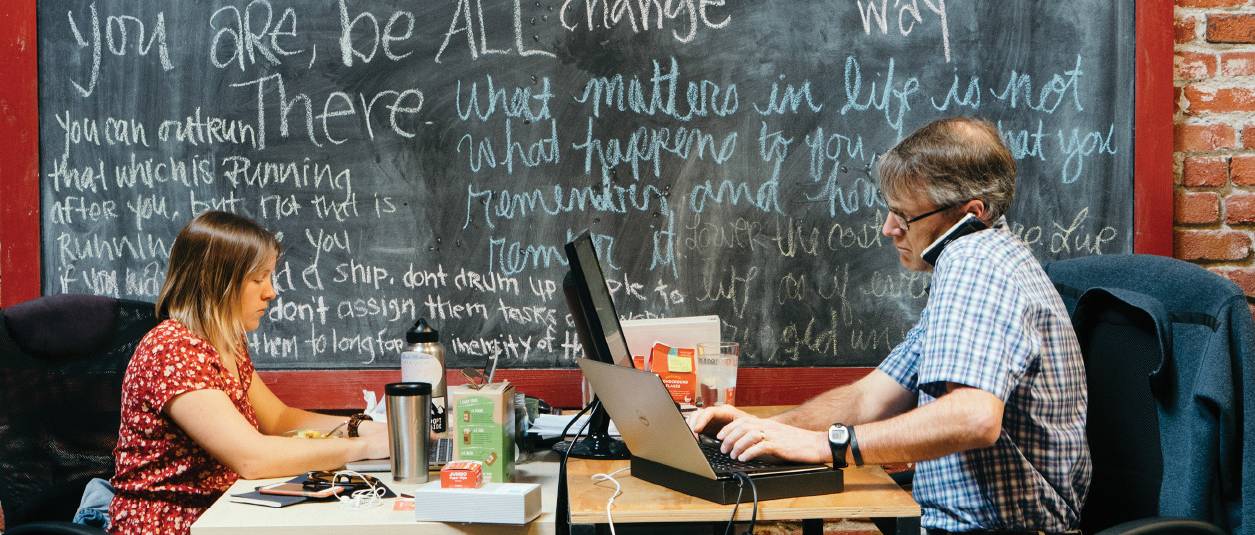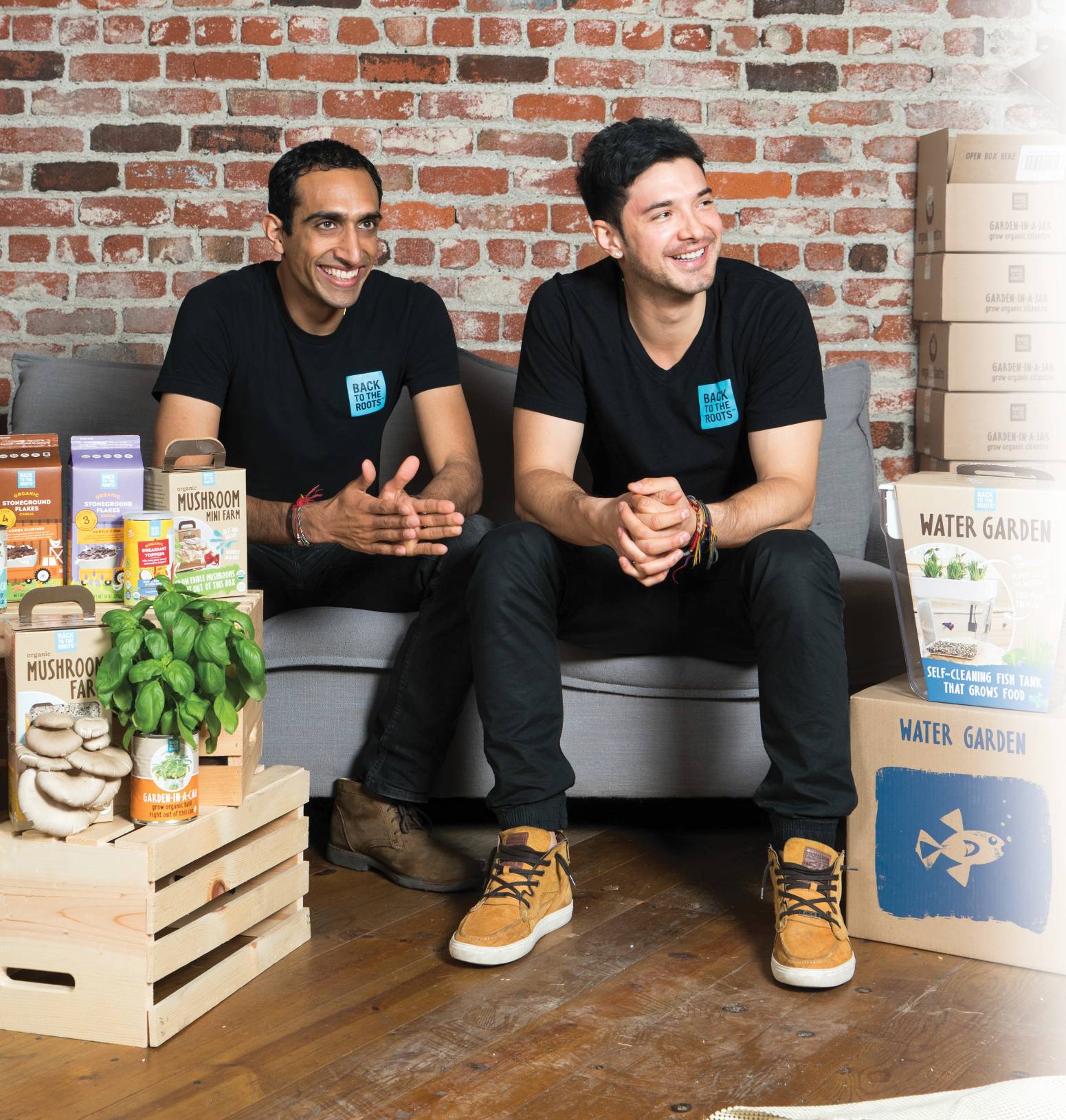
“It has become a big part of our brand that in this generation we can teach ourselves anything.”
AT A GLANCE
Founded: 2010
Location: Oakland, CA
Team Members: 12
Structure: For-profit
Founders: Nikhil Arora (29) and Alejandro Velez (28)
Sitting across a table from Nikhil Arora and Alejandro (Alex) Velez, their youthful exuberance permeating the space, it feels as though their success is inevitable. Yes, they both bring Berkeley educations and extensive business acumen to the table, but what sets the duo apart is their brotherly partnership (the two still carpool to work every morning) and the joy, enthusiasm, and passion they bring to everything they do. As a result, before the co-founders turn 30 they will have brought 17 products to market, closed millions in financing, and will be at the helm of one of the most exciting food companies in the country: Back to the Roots.
We spent the day with Velez and Arora at their Oakland office to understand the secrets to their success, the lessons they’ve learned along the way, and what their mission of “making food personal again” will require.
Tell us the story of conceptualizing Back to the Roots.
Nikhil Arora: We started off with zero background in anything to do with mushrooms, agriculture, or farming; we knew nothing about any of them. We were both undergrad students at UC Berkeley. I was studying business and poli-sci, and Alex was studying business. Going into our senior year, we both thought we knew that we were going into the corporate world.
Alex had an offer to go into investment banking — he literally had signed the job offer, had an apartment set in New York, and thought he knew what he was doing. I thought I was going into consulting. Three months before graduation, we were sitting in this business ethics class about sustainability, and the professor mentioned that you can grow mushrooms on coffee grounds. His point was that people were cutting down trees to grow mushrooms when they could be grown on coffee grounds, but then he went on to other topics, and for some reason, out of the 150 people in that class, we were the two crazy kids who thought that was kind of cool. We both emailed the professor independently and he put us in touch since we were both excited about it.
We met up and just started kicking around ideas, putting down the finance books, checked out some mycology books, and started to YouTube how to grow mushrooms. It has become a big part of our brand that in this generation we can teach ourselves anything. There’s no excuse anymore not to figure something out — we always joke that we taught ourselves to grow mushrooms on YouTube. Eventually we decided: enough researching and reading, let’s just try it out, and we ended up planting these ten paint buckets of mushrooms in Alex’s fraternity kitchen. Then we went off on spring break.
Alex got back to his fraternity and he gave me a call and he was screaming, “You’ve got to get up here!” When I arrived, nine of the ten buckets were completely contaminated with mold and were really nasty, but one of them had a beautiful crop of oyster mushrooms. We walked the bucket over to Chez Panisse, which is one of the nicest restaurants in Berkeley. The head chef, Alice Waters, happened to be there, and we said, “Hey, Alice, we grew mushrooms on coffee grounds.” She must have felt bad for us, but she had one of her chefs sauté them and he said they were delicious! That was our first moment of validation. Fast-forward a few weeks later, and we won a $5,000 grant in a social innovation competition.
We said to each other, “Are we doing this, or what?” and decided to go for it. Forget banking, forget consulting, full-time mushroom farming it is! That’s how the company got started.
How did your families feel about that at graduation? Were they supportive?
Alejandro Velez: Friends were the ones that weren’t supportive. At the time, there was zero doubt in my mind that investment banking would be my future. A lot of my friends were also going into finance and going to New York to do it, and I was the guy that had pushed them to go this route. So when I said that I was not only doing something different, but that I was going to grow mushrooms instead, there was a lot of pushback from friends — really close ones, too. But our families were super supportive.
What are the biggest lessons that you guys have learned so far since starting Back to the Roots? What has been the hardest part of transitioning from just the two of you to being a larger company?
AV: One of our lessons came from one of our mentors, Jon Weinberg, who also became an investor. At one point, he asked us, “What are your values?” And Nikhil launched into this whole thing about my finance background and how I would create a model to evaluate the value of our company. And he just stopped us and said, “No, not your value, your values. What do you stand for? What do you care about? Until you have that figured out, nothing else is going to matter.”
So we did an exercise to develop our values; and to be honest, at the time we thought we were wasting our time. We thought, “Let’s just come up with an acronym and then figure out values based on the acronym.” But it was funny because the process ends up teaching you things you have no idea about. And now our values are some of the most important things to us. How does the team talk to one another? How do we evaluate if somebody should join the Back to the Roots family or not? It is all founded on our values.
That’s what culture is all about: values. It all comes down to what happens without people watching. And when we recruit according to our values, a lot of things can be solved on their own.
NA: We’ve always had an intrinsic bond and understanding of each other, so it was strange when someone told us to put our values down on paper. We were like, “Why? It’s just the two of us — we know what we’re doing.” But the moment we started hiring people and building out our regional sales team and our warehouse team, that’s when it clicked. It’s so true that it’s all about the people, and we know that now.
The other main lesson is to focus, which is still a challenge every day for me. I’ve heard that true focus is saying no to the things you really want to do. There are a million things you can do each day in a small company, and figuring out the right ones to do is a tough challenge.
What are your values?
NA: Family.
AV: Home.
NA: Hustle.
AV: Passion. Universal happiness.
How did you guys go from growing mushrooms on coffee grounds to developing the first grow kits and then the Water Garden?
NA: People were always asking to come visit our little mushroom farm that we had in a 500-square-foot warehouse. We started doing tours with schools, kids, families; people just wanted to come see it, and some of them asked if they could take some fungus home and grow it themselves. So we realized there was more there than just what we were growing; people wanted to know how we were growing the mushrooms and do it themselves.
Our first Mushroom Kit was just a big clear plastic bag that we slapped a FedEx sticker on. We were so proud of it and we showed it to one of our distributors like it was the next iPhone, and he told us it was the most disgusting thing he’d ever seen! He told us to go back to our R&D team, which of course was just us, and figure it out. That was when we first started understanding the power of fun, functional design, and led us to where we are now. Now we want to be the Pixar of food, which means that a 4-year-old and a 40-year-old can both look at something and enjoy it equally but for different reasons.
The important thing about the Mushroom Kits was not how many mushrooms people were getting from their crops, but that they connected people back to food. The why and the how were more important than the what. Just as we shifted the big mushroom farm down to a tabletop version, we decided to do the same thing with a hydroponics farm by creating the Water Garden.
You guys continued to iterate from there; what is the process around new product development and how you guys know when an idea is good enough to pursue?
NA: This last year was a massive, transformative year for us. Last year we had just two products, the Mushroom Kit and the Water Garden. Now we have 17 products, with all the different versions of everything.
People always ask, “How do you get from Mushroom Kits to a cereal?” and for us it’s all just food. It’s just a matter of how you engage with it. Sometimes you want to grow it yourself with your family and kids, sometimes you’re running out the door and you just want something to do it for you, but we believe the underlying trust and transparency shouldn’t change.
We started in the produce aisle, where you can have a really emotional connection to the food. Ten feet over in the grocery aisles, there are all these different ingredients, regulations, manufacturing principles, and lack of transparency involved. We’ve taken the design, packaging, and convenience of the grocery aisle and brought the trust and transparency of the produce aisle because you are growing it yourself. We’re the first company to connect these two, with the same underlying values, with ready-to-eat and ready-to-grow products through our mission to undo food and undo categories.
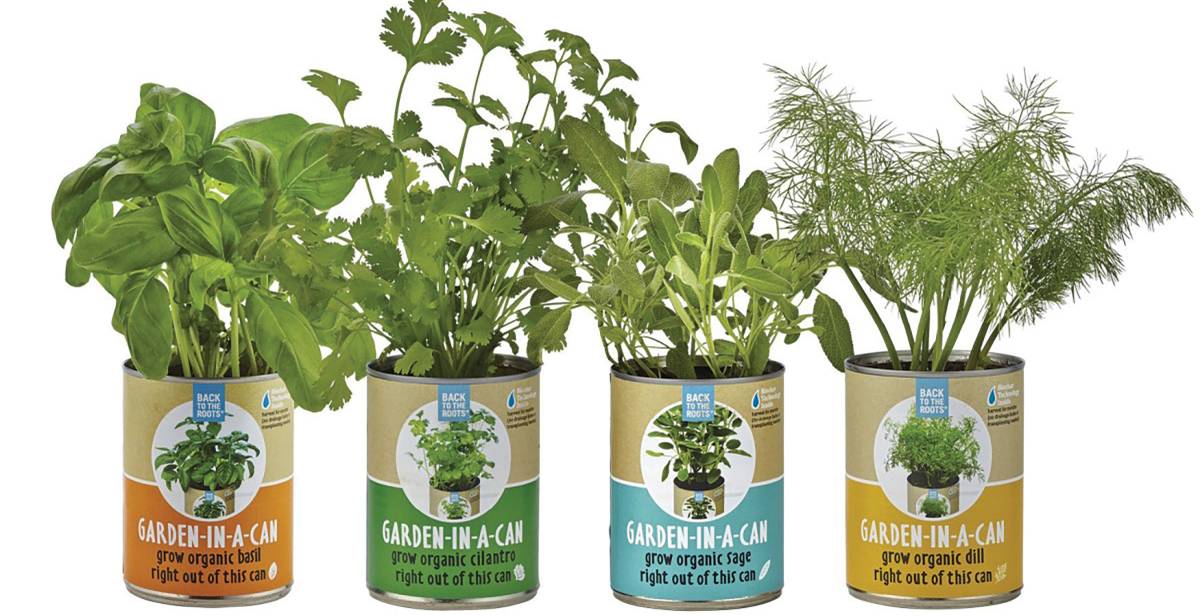
“I think the fact that we can freely come to work and feel productive is one of the pleasures of life — to feel like we’re adding to society and doing it with a purpose.”
AV: We’ve done it by bringing a brand to produce, and now we are bringing that same brand of integrity back to groceries. We think that is a huge opportunity.
Since you’ve recently closed an investment round, what advice do you have for others seeking to raise capital?
AV: I will quote our board member and one of our bigger angel investors and mentors, John Foraker from Annie’s. Before the raise, he said, “Guys, prepare for this. This is going to be a contact sport.”
We didn’t really understand what that meant until we started going through it. The support we’ve had has been humbling, and we’ve been so lucky, but investors push you on so many things — as they should. It makes you disciplined, because they ask and probe on all of the things that can put you out of business, but it’s like standing there naked for a few months and letting somebody take shots at you. It really is like a contact sport.
NA: We are lucky to be doing this at a time when people have done this before who have proven that you can embed a mission in your company and make money. We’re not the crazy ones anymore; this is now the cool thing to do and the right thing to do. And it’s all because folks have built the sustainability space over the last 25 years. Whole Foods was started by long-haired hippies that people made fun of at the time, and now it’s a well-known company on Wall Street. Everything we do today is built on that foundation, and it is our job, our responsibility, to carry that torch and run even faster and harder to build on that legacy. We feel honored to be surrounded by some of these pioneers, guys like John Foraker, Gary Hirshberg , and Kevin Cleary .
You guys really seem to still enjoy each other’s company despite the stress of running a company. How do you guys maintain your friendship?
NA: Before anything else, I think it comes down to values and respect. On the first day we met, two things were clear: we shared the same values in terms of family, and we were going to work our butts off.
I really like the idea “speak like you’re right, listen like you’re wrong.” That can only happen when you have underlying shared values and respect. For me, when we disagree, I know he’s the smartest person I know so there must be something there that I’m missing. We have the same end goal and are coming from a place of alignment, so everything else is just figuring out the details. But like anything, we have to work at the relationship, and as the team grows and we get busier, we have to make sure we come together and communicate. That’s become more and more important as we continue to grow.
Acknowledging that like any healthy family there’s always some degree of conflict, how do you guys approach managing conflict?
NA: I think it comes down to communication. Just like we build our products around radical transparency, we instill transparency in our team.
AV: We embraced early on design-based thinking. In our design brainstorm sessions, we implemented the idea that there are no bad ideas in the room — that you’re building on each other’s idea. Any idea goes, everything gets put into the pot, and nobody owns any ideas; they’re the team’s ideas. We’ve applied those principles across the board for how we have meetings and how we interact with each other. Good design is not just a core element to every one of our products, it’s also a core element of how we interact.
What advice do you guys have on boards? What do you look for in board members, and how do you structure board meetings?
AV: We actually haven’t had an official board meeting yet, but we will soon. But we have had advisors and investors for a little while. I would say the most important thing that comes to mind is love — there has to be true love from at least the initial two board members. You want to have at least two key folks early on who are with you no matter what. Share what you’re doing, make them fall in love with what you care about, with your vision, with what you’re going to make happen, and then do it again and again. You have to build that trust and that relationship first, and then it slowly becomes something more. But it’s difficult. I can’t imagine immediately having a transactional board where you raise a lot of money and give someone a board seat, because you don’t know if that person is going to be there for you when the shit hits the fan. That’s why it is important to have those key players early on.
How do you balance the amount of time and energy it takes to build a business with finding time to feed and nurture yourselves and stay inspired?
NA: I think the word “balance” sets false expectations because it assumes there is a 50/50 split. But really it’s about work-life integration. Inspiration has to come from the work itself, and we have to take pleasure out of doing the work itself. We carpool to work together, every day since we started, and he picks me up at 6:45 in the morning and usually drops me off at 9:15. You can’t do that every single day, year after year, if you don’t find inspiration and pleasure in the work itself.
I always go back to the mantra “happiness is doing what you love with people you love.” I think it really boils down to that. As long as that’s true for us every day, we’ll keep on working together and having a blast.
Outside of that, you need support. We’re both super close to our families, and that is really important to both of us.
We also don’t have set vacation days for our team members. We want everyone to be here for the long run to help grow Back to the Roots, and we know that to do that you’ve got to be emotionally fulfilled, which means different things to different people at different stages of life. So folks can take all the time they need as long as they are responsible and give us a proper heads-up. Don’t take a two-month trip and tell us the day before, but if you’re here for ten years, everything is a blip over the long-term trajectory, and we want you to do what you need to do to feel personally fulfilled.
AV: You also can’t take yourself too seriously. We always say, “When you walk through that door, you’re 13 years old.” It’s a paradox, because we want to take our job seriously, and a lot of our team come from incredible backgrounds and we expect and demand excellence. But it’s a better balance to have fun and not take yourself too seriously.
NA: But there is no sugar-coating it: it’s a lot of work.
AV: It is, but we don’t do well with people complaining. I mean, we get to wake up every morning and come to work without worrying about our personal security, which is a real issue in most of the world. I think the fact that we can freely come to work and feel productive is one of the pleasures of life — to feel like we’re adding to society and doing it with a purpose. But that’s one of the problems with Millennials, too; we’re always pursuing happiness all of the time. Let’s just work and appreciate work for work itself. Work is hard, but it’s also awesome because of that.
What are your thoughts on food and technology in the modern food movement?
NA: I think American culture is built on its history of Manifest Destiny, where progress is always better, new is always better, but with food, that creates risks. I think that’s why we are seeing two divergent paths in the food movement. We all agree that the food system is absolutely broken, but there are disagreements on how food and technology should come together.
We’re seeing one path based on technology, which is trying to speed up food and invent new food — laboratory-based food. It has patented food based on technology, and there are hundreds of millions of dollars of tech money going into this. Companies like Beyond Meat, Impossible Foods, and Soylent are inventing new food. Intellectual property in this world is patented food.
The flip side of this is to use technology for distribution, logistics, and transparency, but let’s take food back to how it used to be and use technology to help you understand where your food came from. It’s one of our mantras that food should be made in a kitchen, not in a lab.
Where do you want to see Back to the Roots go in the next few years?
NA: At this point, we feel lucky and blessed to have started out so young, and we’ve learned so much and are still learning. We feel like we’re just getting started — like we’ve just run a warm-up lap with our brand. We want to build this brand to be around for 100 years.
When we look at what is success for us, I think we look at the next generation of kids that are growing Mushroom Kits and Gardens-in-a-Can and are swapping their Kellogg’s and General Mills cereals for our stone-ground, three-ingredient cereal. We want kids to be curious about where food comes from, and when they grow up we want food to be personal again. We feel lucky to have raised capital from people who believe in the same long-term vision of making that shift in the food system.
What is inspiring you guys right now and giving you hope for the future?
AV: Being able to bring healthier food to schools. Change has to start in schools. The poorest kids in America right now are eating two out of their three meals at school. The rich kids get to have their lunch packed, but the other kids are being affected the most and getting the shittiest food. But now companies that are making food better, like Back to the Roots, are getting into schools and addressing this head-on.
NA: I’m inspired by walking into our office every day and seeing our team. It’s not just us anymore, and seeing a group of people who have just as much confidence in what we’re trying to do is a really cool feeling and really motivates the two of us. It’s inspiring as hell to walk into this place every day.

2010
Organic Mushroom Farm and Organic Mushroom Mini Farm

2012
Water Garden

2015
Organic Stone-ground Flakes (California Whole Wheat, Purple Corn, and Cocoa Clusters varieties)

2015
Organic Breakfast Toppers (blueberry, raisin, and date varieties)

2015
Garden-in-a-Can (organic basil, cilantro, sage, and dill varieties)
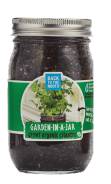
2015
Garden-in-a-Jar (organic basil and cilantro varieties)
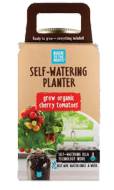
2015
Organic Self-Watering Planter

2016
Organic Stone-ground Flakes (Biodynamic Cinnamon Clusters — the world’s first biodynamic breakfast cereal)
Nikhil and Alejandro’s Top 3 Pieces of Advice For Entrepreneurs
1. Do Something Worth Working Your Ass Off For
Start a business that addresses one of the five biggest challenges that humanity faces today: food, poverty, health, education, or energy. If you’re addressing one of those, then you’re at least doing something that will make your kids and your grandkids proud, even if you fail miserably. It used to be if you could solve a problem that consumers face, then you could start a company. But now it needs to be a bigger, societal problem. And if you start with that, you get a lot more support, and you can surround yourself with people and mentors who are thinking big.
2. Balance Vision With the Details
This is actually based on a Will Smith quote — you don’t build a great wall overnight; you lay each brick as perfectly as you can and over time you’ll build a great wall. You have to have that big vision, but it can seem so lofty and far away. For us, solving world hunger sounds impossible, right? So we just said, “We’re going to make the best damn Mushroom Kit the world has ever seen!” It’s important to break things down and balance the big vision with the details.
3. Go All-In
One of our mentors told us, “entrepreneurship is like jumping off a five-story building and building your wings on the way down.” Don’t be afraid to dive in head-first.
